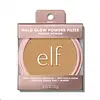e.l.f. cosmetics Halo Glow Powder Filter Pressed Powder Versus Maybelline Fit Me Matte + Poreless Powder
What's inside
What's inside
 Key Ingredients
Key Ingredients

 Benefits
Benefits

No benefits
 Concerns
Concerns

No concerns
 Ingredients Side-by-side
Ingredients Side-by-side

Synthetic Fluorphlogopite
Silica
AbrasiveDimethicone
EmollientPolymethylsilsesquioxane
Boron Nitride
AbsorbentZinc Stearate
Cosmetic ColorantZinc Palmitate
Octyldodecyl Stearoyl Stearate
EmollientTriethoxycaprylylsilane
Diisostearyl Malate
EmollientIsoamyl Laurate
EmollientAluminum Starch Octenylsuccinate
AbsorbentPhenoxyethanol
PreservativeCaprylyl Glycol
EmollientSynthetic Sapphire
Squalane
EmollientTin Oxide
AbrasiveHydrolyzed Sodium Hyaluronate
Skin ConditioningCI 77492
Cosmetic ColorantTitanium Dioxide
Cosmetic ColorantCI 77163
Cosmetic ColorantCI 77491
Cosmetic ColorantCI 77499
Cosmetic ColorantSynthetic Fluorphlogopite, Silica, Dimethicone, Polymethylsilsesquioxane, Boron Nitride, Zinc Stearate, Zinc Palmitate, Octyldodecyl Stearoyl Stearate, Triethoxycaprylylsilane, Diisostearyl Malate, Isoamyl Laurate, Aluminum Starch Octenylsuccinate, Phenoxyethanol, Caprylyl Glycol, Synthetic Sapphire, Squalane, Tin Oxide, Hydrolyzed Sodium Hyaluronate, CI 77492, Titanium Dioxide, CI 77163, CI 77491, CI 77499
 Reviews
Reviews

Ingredients Explained
These ingredients are found in both products.
Ingredients higher up in an ingredient list are typically present in a larger amount.
Caprylyl Glycol is a humectant and emollient, meaning it attracts and preserves moisture.
It is a common ingredient in many products, especially those designed to hydrate skin. The primary benefits are retaining moisture, skin softening, and promoting a healthy skin barrier.
Though Caprylyl Glycol is an alcohol derived from fatty acids, it is not the kind that can dry out skin.
This ingredient is also used as a preservative to extend the life of products. It has slight antimicrobial properties.
Learn more about Caprylyl GlycolCi 77491 is also hydrated iron III oxide. It's sole purpose is to give a red/pink hue to products.
Iron III oxides are classified as inorganic chemicals for coloring.
Synthetically created Ci 77491 is considered safer than those naturally found. This is because the synthetically created version may contain less impurities. Iron oxides are generally non-toxic and non-allergenic.
Learn more about CI 77491Ci 77492 is also hydrated iron III oxide. It's sole purpose is to give a yellow hue to products.
Iron III oxides are classified as inorganic chemicals for coloring.
Synthetically created Ci 77492 is considered safer than those naturally found. This is because the synthetically created version may contain less impurities. Iron oxides are generally non-toxic and non-allergenic.
Learn more about CI 77492Ci 77499 is also hydrated iron III oxide. It is created from mixing red and black iron oxides. This helps give shades of darkness to a product.
Iron III oxides are classified as inorganic chemicals for coloring.